Related Research Articles
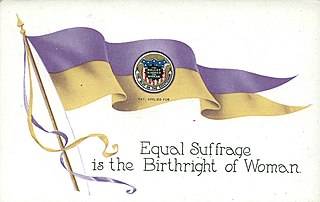
The National American Woman Suffrage Association (NAWSA) was an organization formed on February 18, 1890, to advocate in favor of women's suffrage in the United States. It was created by the merger of two existing organizations, the National Woman Suffrage Association (NWSA) and the American Woman Suffrage Association (AWSA). Its membership, which was about seven thousand at the time it was formed, eventually increased to two million, making it the largest voluntary organization in the nation. It played a pivotal role in the passing of the Nineteenth Amendment to the United States Constitution, which in 1920 guaranteed women's right to vote.

The College Equal Suffrage League (CESL) was an American woman suffrage organization founded in 1900 by Maud Wood Park and Inez Haynes Irwin, as a way to attract younger Americans to the women's rights movement. The League spurred the creation of college branches around the country and influenced the actions of other prominent groups such as National American Woman Suffrage Association (NAWSA).

The Minnesota Woman Suffrage Association (MWSA) operated from 1881 to 1920. The organization was part of the broader women's suffrage movement in the United States and it sought to secure the right of women to vote in Minnesota. Its members organized marches, wrote petitions and letters, gathered signatures, gave speeches, and published pamphlets and broadsheets to compel the Minnesota Legislature to pass legislation that recognized their right to vote. As a result of the movement's efforts, the legislature ratified the Nineteenth Amendment to the United States Constitution in 1919, which prohibited the denial of citizens to vote based on sex.

Women's suffrage was established in the United States on a full or partial basis by various towns, counties, states and territories during the latter decades of the 19th century and early part of the 20th century. As women received the right to vote in some places, they began running for public office and gaining positions as school board members, county clerks, state legislators, judges, and, in the case of Jeannette Rankin, as a member of Congress.
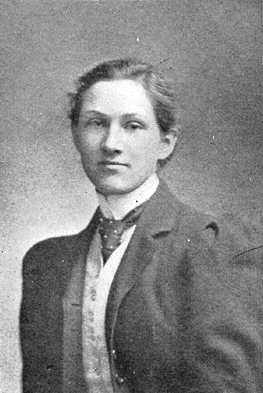
Edith Houghton Hooker was an American suffragist and social worker. She was a leader of the suffrage movement in Maryland in the early twentieth century and was posthumously inducted into the Maryland Women's Hall of Fame. She was a maternal aunt of actress Katharine Hepburn.
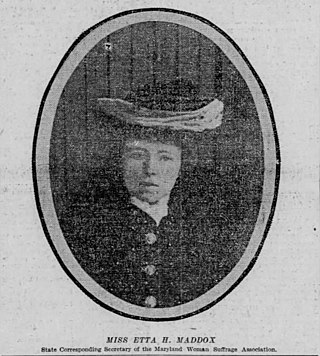
Henrietta Haynie Maddox was a vocalist, lawyer and suffragist. Maddox became the first woman in Maryland licensed to practice law in 1902. She fought for the rights of women to take the bar exam and practice law in the state of Maryland. She was a successful vocalist who studied at the Peabody Conservatory of Music before starting a second career as an attorney. She was the co-founder of the Maryland Woman Suffrage Association in 1894 and campaigned for equal pay for equal work. Maddox wrote the first Maryland suffrage bill introduced to the General Assembly on February 23, 1910.

Women's suffrage in Virginia was granted in 1920, with the ratification of the Nineteenth Amendment. The General Assembly, Virginia's governing legislative body, did not ratify the Nineteenth Amendment until 1952. The argument for women's suffrage in Virginia began in 1870, but it did not gain traction until 1909 with the founding of the Equal Suffrage League of Virginia. Between 1912 and 1916, Virginia's suffragists would bring the issue of women's voting rights to the floor of the General Assembly three times, petitioning for an amendment to the state constitution giving women the right to vote; they were defeated each time. During this period, the Equal Suffrage League of Virginia and its fellow Virginia suffragists fought against a strong anti-suffragist movement that tapped into conservative, post-Civil War values on the role of women, as well as racial fears. After achieving suffrage in August 1920, over 13,000 women registered within one month to vote for the first time in the 1920 United States presidential election.
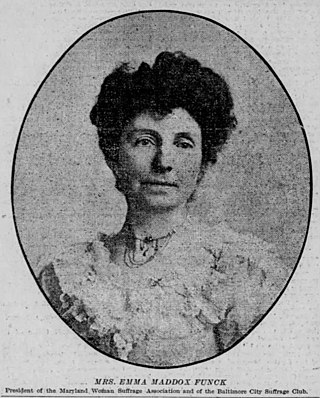
Emma Maddox Funck was an American suffragist and served as president of the Maryland Woman Suffrage Association (MWSA).

This is a timeline of women's suffrage in Montana. The fight for women's suffrage in Montana started early, before Montana became a state. In 1887, women gained the right to vote in school board elections and on tax issues. In the years that followed, women battled for full, equal suffrage, which culminated in a year-long campaign in 1914 when they became one of eleven states with equal voting rights for most women. Montana ratified the Nineteenth Amendment on August 2, 1919 and was the thirteenth state to ratify. Native American women voters did not have equal rights to vote until 1924.

Attempts to achieve women's suffrage in Montana started while Montana was still a territory. The Women's Christian Temperance Union (WCTU) was an early organizer that supported suffrage in the state, arriving in 1883. Women were given the right to vote in school board elections and on tax issues in 1887. When the state constitutional convention was held in 1889, Clara McAdow and Perry McAdow invited suffragist, Henry Blackwell, to speak to the delegates about equal women's suffrage. While that proposition did not pass, women retained their right to vote in school and tax elections as Montana became a state. In 1895, National American Woman Suffrage Association (NAWSA) came to Montana to organize local groups. Montana suffragists held a convention and created the Montana Woman's Suffrage Association (MWSA). Suffragists continued to organize, hold conventions and lobby the Montana Legislature for women's suffrage through the end of the nineteenth century. In the early twentieth century, Jeannette Rankin became a driving force around the women's suffrage movement in Montana. By January 1913, a women's suffrage bill had passed the Montana Legislature and went out as a referendum. Suffragists launched an all-out campaign leading up to the vote. They traveled throughout Montana giving speeches and holding rallies. They sent out thousands of letters and printed thousands of pamphlets and journals to hand out. Suffragists set up booths at the Montana State Fair and they held parades. Finally, after a somewhat contested election on November 3, 1914, the suffragists won the vote. Montana became one of eleven states with equal suffrage for most women. When the Nineteenth Amendment was passed, Montana ratified it on August 2, 1919. It wasn't until 1924 with the passage of the Indian Citizenship Act that Native American women gained the right to vote.
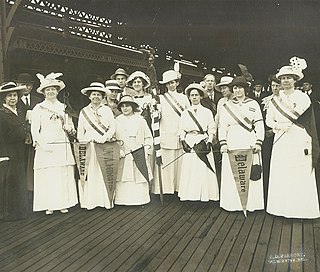
Women's suffrage in Delaware began in the late 1860s, with efforts from suffragist, Mary Ann Sorden Stuart, and an 1869 women's rights convention held in Wilmington, Delaware. Stuart, along with prominent national suffragists lobbied the Delaware General Assembly to amend the state constitution in favor of women's suffrage. Several suffrage groups were formed early on, but the Delaware Equal Suffrage Association (DESA) formed in 1896, would become one of the major state suffrage clubs. Suffragists held conventions, continued to lobby the government and grow their movement. In 1913, a chapter of the Congressional Union (CU), which would later be known at the National Woman's Party (NWP), was set up by Mabel Vernon in Delaware. NWP advocated more militant tactics to agitate for women's suffrage. These included picketing and setting watchfires. The Silent Sentinels protested in Washington, D.C., and were arrested for "blocking traffic." Sixteen women from Delaware, including Annie Arniel and Florence Bayard Hilles, were among those who were arrested. During World War I, both African-American and white suffragists in Delaware aided the war effort. During the ratification process for the Nineteenth Amendment, Delaware was in the position to become the final state needed to complete ratification. A huge effort went into persuading the General Assembly to support the amendment. Suffragists and anti-suffragists alike campaigned in Dover, Delaware for their cause. However, Delaware did not ratify the Nineteenth Amendment until March 6, 1923, well after it was already part of the United States Constitution.

Women's suffrage in Florida had two distinct phases. The first women's suffrage effort in Florida was led by Ella C. Chamberlain in the early 1890s. Chamberlain began writing a women's suffrage news column, started a mixed-gender women's suffrage group and organized conventions in Florida.
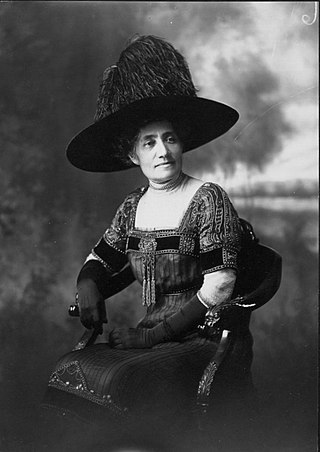
Women's suffrage in Hawaii began in the 1890s. However, when the Hawaiian Kingdom ruled, women had roles in the government and could vote in the House of Nobles. After the overthrow of Queen Liliʻuokalani in 1893, women's roles were more restricted. Suffragists, Wilhelmine Kekelaokalaninui Widemann Dowsett and Emma Kaili Metcalf Beckley Nakuina, immediately began working towards women's suffrage. The Women's Christian Temperance Union (WCTU) of Hawaii also advocated for women's suffrage in 1894. As Hawaii was being annexed as a US territory in 1899, racist ideas about the ability of Native Hawaiians to rule themselves caused problems with allowing women to vote. Members of the National American Woman Suffrage Association (NAWSA) petitioned the United States Congress to allow women's suffrage in Hawaii with no effect. Women's suffrage work picked up in 1912 when Carrie Chapman Catt visited Hawaii. Dowsett created the National Women's Equal Suffrage Association of Hawai'i that year and Catt promised to act as the delegate for NAWSA. In 1915 and 1916, Prince Jonah Kūhiō Kalanianaʻole brought resolutions to the U.S. Congress requesting women's suffrage for Hawaii. While there were high hopes for the effort, it was not successful. In 1919, suffragists around Hawaii met for mass demonstrations to lobby the territorial legislature to pass women's suffrage bills. These were some of the largest women's suffrage demonstrations in Hawaii, but the bills did not pass both houses. Women in Hawaii were eventually franchised through the passage of the Nineteenth Amendment.

This is a timeline of women's suffrage in Maine. Suffragists began campaigning in Maine in the mid 1850s. A lecture series was started by Ann F. Jarvis Greely and other women in Ellsworth, Maine in 1857. The first women's suffrage petition to the Maine Legislature was sent that same year. Women continue to fight for equal suffrage throughout the 1860s and 1870s. The Maine Woman Suffrage Association (MWSA) is established in 1873 and the next year, the first Woman's Christian Temperance Union (WCTU) chapter was started. In 1887, the Maine Legislature votes on a women's suffrage amendment to the state constitution, but it does not receive the necessary two-thirds vote. Additional attempts to pass women's suffrage legislation receives similar treatment throughout the rest of the century. In the twentieth century, suffragists continue to organize and meet. Several suffrage groups form, including the Maine chapter of the College Equal Suffrage League in 1914 and the Men's Equal Suffrage League of Maine in 1914. In 1917, a voter referendum on women's suffrage is scheduled for September 10, but fails at the polls. On November 5, 1919 Maine ratifies the Nineteenth Amendment. On September 13, 1920, most women in Maine are able to vote. Native Americans in Maine are barred from voting for many years. In 1924, Native Americans became American citizens. In 1954, a voter referendum for Native American voting rights passes. The next year, Lucy Nicolar Poolaw (Penobscot), is the Native American living on an Indian reservation to cast a vote.

While women's suffrage in Maine had an early start, dating back to the 1850s, it was a long, slow road to equal suffrage. Early suffragists brought speakers Susan B. Anthony and Lucy Stone to the state in the mid-1850s. Ann F. Jarvis Greely and other women in Ellsworth, Maine, created a women's rights lecture series in 1857. The first women's suffrage petition to the Maine Legislature was also sent that year. Working-class women began marching for women's suffrage in the 1860s. The Snow sisters created the first Maine women's suffrage organization, the Equal Rights Association of Rockland, in 1868. In the 1870s, a state suffrage organization, the Maine Women's Suffrage Association (MWSA), was formed. Many petitions for women's suffrage were sent to the state legislature. MWSA and the Woman's Christian Temperance Union (WCTU) of Maine worked closely together on suffrage issues. By the late 1880s the state legislature was considering several women's suffrage bills. While women's suffrage did not pass, during the 1890s many women's rights laws were secured. During the 1900s, suffragists in Maine continued to campaign and lecture on women's suffrage. Several suffrage organizations including a Maine chapter of the College Equal Suffrage League and the Men's Equal Rights League were formed in the 1910s. Florence Brooks Whitehouse started the Maine chapter of the National Woman's Party (NWP) in 1915. Suffragists and other clubwomen worked together on a large campaign for a 1917 voter referendum on women's suffrage. Despite the efforts of women around the state, women's suffrage failed. Going into the next few years, a women's suffrage referendum on voting in presidential elections was placed on the September 13, 1920 ballot. But before that vote, Maine ratified the Nineteenth Amendment on November 5, 1920. It was the nineteenth state to ratify. A few weeks after ratification, MWSA dissolved and formed the League of Women Voters (LWV) of Maine. White women first voted in Maine on September 13, 1920. Native Americans in Maine had to wait longer to vote. In 1924, they became citizens of the United States. However, Maine would not allow individuals living on Indian reservations to vote. It was not until the passage of a 1954 equal rights referendum that Native Americans gained the right to vote in Maine. In 1955 Lucy Nicolar Poolaw (Penobscot) was the first Native American living on a reservation in Maine to cast a vote.

Women's suffrage in Colorado had an early victory, being the second state to grant women's suffrage and the first to do so through a voter referendum in 1893. Even while Colorado was a territory, lawmakers and other leaders tried to include women's suffrage in laws and later in the state constitution. The constitution did give women the right to vote in school board elections. The first voter referendum campaign was held in 1877. The Woman Suffrage Association of Colorado worked to encourage people to vote yes. Nationally-known suffragists, such as Susan B. Anthony and Lucy Stone spoke alongside Colorado's own Alida Avery around the state. Despite the efforts to influence voters, the referendum failed. Suffragists continued to grow support for women's right to vote. They exercised their right to vote in school board elections and ran for office. In 1893, another campaign for women's suffrage took place. Both Black and white suffragists worked to influence voters, gave speeches, and turned out on election day in a last-minute push. The effort was successful and women earned equal suffrage. In 1894, Colorado again made history by electing three women to the Colorado house of representatives. After gaining the right to vote, Colorado women continued to fight for suffrage in other states. Some women became members of the Congressional Union (CU) and pushed for a federal suffrage amendment. Colorado women also used their right to vote to pass reforms in the state and to support women candidates.

Mary Clare Laurence Brassington was an American suffragist, president of the Delaware Equal Suffrage Association (DESA) from 1915 to 1917.
Mary Bentley Thomas was an American suffragist and president of the Maryland Woman Suffrage Association from 1894 to 1904. She was also involved in the Friends Equal Rights Association and the National American Woman Suffrage Association, holding various offices in both organizations.
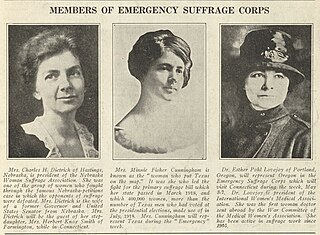
The Suffrage Emergency Corps was a special group of suffragists formed after nearly two-thirds of the states had ratified the Nineteenth Amendment to the United States Constitution. Only one more state was needed to ratify, and suffragists hoped they could convince Governor Marcus H. Holcomb to make his state of Connecticut the thirty-sixth. A team of women, sponsored by the National American Woman Suffrage Association (NAWSA) chose delegates from the other states to travel to Connecticut in early May 1920 to convince the governor to open a special legislative session to consider ratifying the amendment. The event garnered publicity, but it did not convince the governor to proceed with the session.
References
- 1 2 3 4 Schaefer, Kate Murphy. "Maryland Woman Suffrage Association, 1867–1920(?)". Biographical Database of NAWSA Suffragists, 1890–1920– via Alexander Street.
- 1 2 3 Weatherford, Doris, ed. (2004). A History of Women in the United States : State-by-state Reference . Danbury, Connecticut: Grolier Academic Reference. pp. 167-168. ISBN 0-7172-5805-X. OCLC 52631499 – via Internet Archive.
- ↑ Farquhar, William Henry; Moore, Eliza Needles; Miller, Rebecca Thomas; Thomas, Mary Moore; Kirk, Annie B. (1909). Annals of Sandy Spring or Fourteen Years' History of a Rural Community in Maryland. Vol. 3. Allen County Public Library Genealogy Center. Baltimore: Cushings & Bailey. pp. 172 – via Internet Archive.
- ↑ "Sandy Spring". Evening Star. January 24, 1895. p. 10. Retrieved January 13, 2020– via Newspapers.com.
- 1 2 "Demand the Right to Vote". The Baltimore Sun. January 7, 1906. p. 8. Retrieved January 13, 2020– via Newspapers.com.
- 1 2 Spiegelman, Hannah. "Biography of Emma Maddox Funck, 1853-1940". Biographical Database of NAWSA Suffragists, 1890-1920– via Alexander Street.
- 1 2 Miyagawa, Sharon (2014). "Elizabeth King Ellicott (1858-1914)". Maryland State Archives. Retrieved January 15, 2020.
- ↑ "Third Suffrage League". The Baltimore Sun. September 22, 1911. p. 14. Retrieved January 13, 2020– via Newspapers.com.